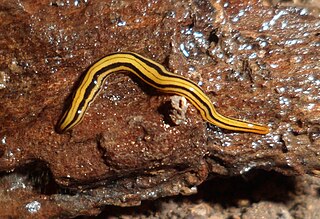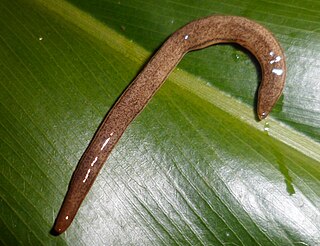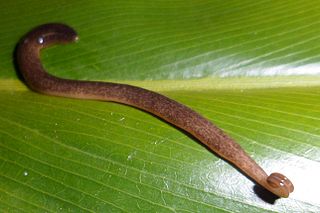Related Research Articles

Geoplanidae is a family of flatworms known commonly as land planarians or land flatworms.

Luteostriata is a genus of land planarians from Brazil characterized by a yellow body with dark longitudinal stripes.

Supramontana is a genus of land planarians from South America.

Choeradoplana is a genus of land planarians from South America.

Caenoplanini is a tribe of land planarians in the subfamily Rhynchodeminae mostly found throughout the Australasian and Oceanian realms.

Issoca is a genus of land planarians from Brazil.
Robert Edward Ogren was an American zoologist.

Marionfyfea is a genus of land planarians from Antarctic Islands off New Zealand. However, a species has been described from specimens found in Europe, probably introduced.
Anzoplana is a genus of land planarians from Australia, currently comprising a single species, Anzoplana trilineata.

Australoplana also known as Australian flatworm is a genus of land planarians from Australia and New Zealand.

Kontikia is a genus of land planarians native from islands in the Indo-Pacific region, but several species have been introduced elsewhere.
Timyma is a genus of land planarians that currently contains a single species, Timyma juliae. The species was found in Chile, but its anatomic features indicate that it is probably introduced in South America, being native from somewhere in the Pacific.

Artioposthia is a genus of land planarians from the Australasian and Indo-Pacific countries. Several species have also been introduced in Europe.
Coleocephalus is a genus of land planarians that currently contains a single species, Coleocephalus fuscus, from the Enderby Island, New Zealand.
Tasmanoplana is a genus of land planarians from Australia.
Lenkunya is a genus of land planarians from Australia.

Dolichoplana is a genus of land planarians in the tribe Rhynchodemini.
Geobenazzia is a genus of land planarians that currently contains a single species, Geobenazzia tyrrhenica, found in Elba, Italy.
Beauchampius is a genus of land planarians in the tribe Pelmatoplanini.
Pelmatoplana is a genus of land planarians in the tribe Pelmatoplanini.
References
- 1 2 3 4 Winsor, Leigh (1991). "A new genus and species of terrestrial flatworm from the central highlands of New Caledonia (Tricladida Terricola)". Memoirs du Museum National d'Histoire Naturelle. 149: 19–30.
- ↑ Ogren, R. E.; Kawakatsu, M. (1991). "Index to the species of the family Geoplanidae (Turbellaria, Tricladida, Terricola) Part II: Caenoplaninae and Pelmatoplaninae". Bulletin of Fujis Women's College. 29: 35–58.
